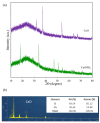Bio-Composite Films Based on Carboxymethyl Chitosan Incorporated with Calcium Oxide: Synthesis and Antimicrobial Activity
- PMID: 39274027
- PMCID: PMC11397112
- DOI: 10.3390/polym16172393
Bio-Composite Films Based on Carboxymethyl Chitosan Incorporated with Calcium Oxide: Synthesis and Antimicrobial Activity
Abstract
The utilization of biopolymers incorporated with antimicrobial agents is extremely interesting in the development of environmentally friendly functional materials for food packaging and other applications. In this study, the effect of calcium oxide (CaO) on the morphological, mechanical, thermal, and hydrophilic properties as well as the antimicrobial activity of carboxymethyl chitosan (CMCH) bio-composite films was investigated. The CMCH was synthesized from shrimp chitosan through carboxymethylation, whereas the CaO was synthesized via a co-precipitation method with polyethylene glycol as a stabilizer. The CMCH-CaO bio-composite films were prepared by the addition of synthesized CaO into the synthesized CMCH using a facile solution casting method. As confirmed by XRD and SEM, the synthesized CaO has a cubic shape, with an average crystalline size of 25.84 nm. The synthesized CaO exhibited excellent antimicrobial activity against Escherichia coli (E. coli) and Staphylococcus aureus (S. aureus) (>99.9% R). The addition of CaO into CMCH improved the mechanical and hydrophobic properties of the CMCH-CaO films. However, it resulted in a slight decrease in thermal stability. Notably, the CMCH-CaO10% films exhibited exceptional antimicrobial activity against E. coli (98.8% R) and S. aureus (91.8% R). As a result, such bio-composite films can be applied as an active packaging material for fruit, vegetable, or meat products.
Keywords: active packaging film; antimicrobial activity; calcium oxide (CaO); carboxymethyl chitosan (CMCH); carboxymethylation; co-precipitation; hydrophilicity; polyethylene glycol; synthesis.
Conflict of interest statement
The authors declare no conflicts of interest.
Figures










References
-
- Abdel-Aziz S.M., Asker M.M., Keera A.A., Mahmoud M.G. Microbial food spoilage: Control strategies for shelf life extension. In: Garg N., Abdel-Aziz S.M., Aeron A., editors. Microbes in Food and Health. Springer Nature Switzerland; Cham, Switzerland: 2016. pp. 239–264.
-
- Pandey S., Sharma K., Gundabala V. Antimicrobial Bio-Inspired Active Packaging Materials for Shelf Life and Safety Development: A Review. Food Biosci. 2022;48:101730. doi: 10.1016/j.fbio.2022.101730. - DOI
-
- Mayegowda S.B., Bhoomika S., Nagshetty K., Manjula N.G. Environmental Adequacy of Green Polymers and Biomaterials. In: Agarwal P., Tripathy D.B., Gupta A., Kuanr B.K., editors. Polymeric Biomaterials. 1st ed. CRC Press; Boca Raton, FL, USA: 2022. pp. 193–214.
-
- Zhou J. Ultrafast fabrication of self-healing and injectable carboxymethyl chitosan hydrogel dressing for wound healing. ACS Appl. Mater. Interfaces. 2021;13:24095–24105. - PubMed
-
- Das S.S., Kar S., Singh S.K., Hussain A., Verma P.R.P., Beg S. Carboxymethyl chitosan in advanced drug-delivery applications. In: Hasnain M.S., Beg S., Nayak A.K., editors. Chitosan in Drug Delivery. Academic Press; London, UK: 2022. pp. 323–360.
Grants and funding
- The Murata Science Foundation
- Thailand Research Fund (TRF) Research Team Promotion Grant, RTA, Senior Research Scholar (N42A671052)
- Chiang Mai University under the Center of Excellence in Agro-Bio-Circular-Green Industry (Agro-BCG), Faculty of Agro-Industry, Chiang Mai University [CoE/RG66/67-P001].
LinkOut - more resources
Full Text Sources
Research Materials

